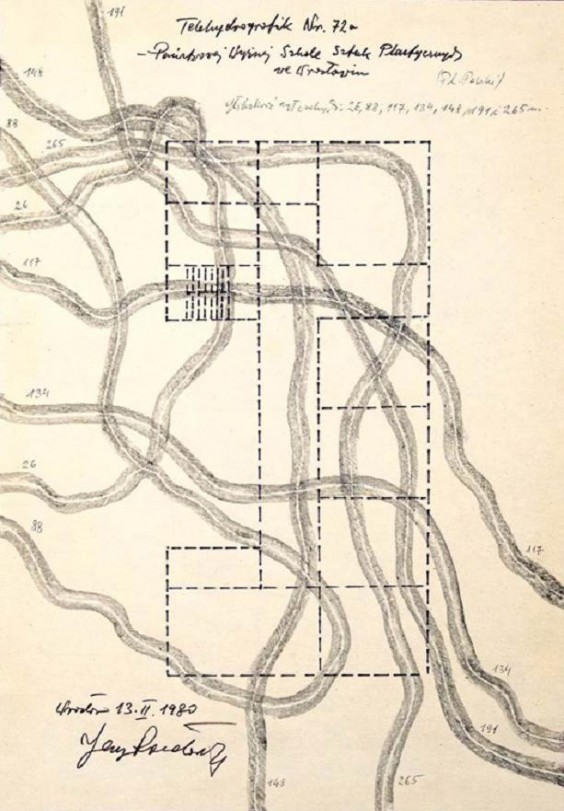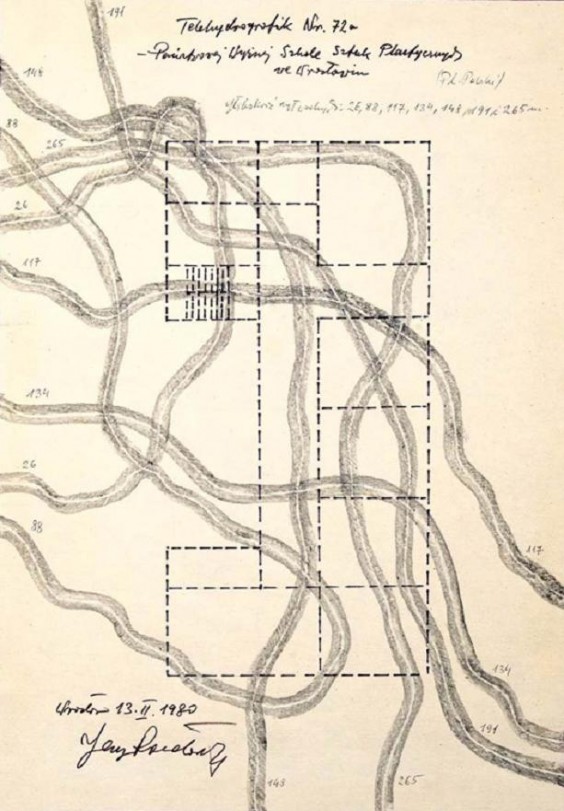18.12.2009-07.02.2010
Telehydrographics was one of the two last series of works made by Jerzy Rosołowicz in 1980. Similar to his other realisations, they can be located – as Stefan Morawski says – “in between”, that is “on the border between art and non-art”. The drawings in which the artist marked the location of ground water were supposed to help to neutralise its negative radiation. The artist formulated his programme for the conscious neutral activities in the second half of the 1960s and its exemplification was, among other things, the neutrdoms which could only be realised in their concept stage but were unfeasible in reality. The artist applied his concept of neutral activities also in Neutronikons – double-sided bas reliefs made of glass lenses of prisms. These “cross-grained optical instruments” referred rather to the capability of seeing itself than reality; they evaded any modernist category of a painting and object or aesthetic mediation and/or representation. The example of a neutral activity, remembered in this exhibition, is the Kineutronikon – an action realised at the Akumulatory 2 Gallery in Poznań in 1975. The artist showed his film Kineutronikon which registered reality viewed through the lenses of the neutronikons. Just after the projection, the film was destroyed in the act of “the anti-documentation of the visible sphere”, the destruction being accompanied by the loud reading of the text On the Neutral Activity. The disappearing film, contradicting the idea of documentation, was a spectacular manifestation of a neutral activity – senseless and useless. The first series of Telehydrographics was shown at the X Gallery in Wrocław in 1980. It was dedicated to the artist’s friends and acquaintances with whom the artist corresponded, advising them on how to prevent from the negative impact of undercurrents. Thirty drawings of this series, presented at the exhibition by Profile Foundation come from the archive of the Akumulatory 2 Gallery, where they were shown at Jerzy Rosołowicz’s exhibition Psychotronikon in 1981.
This exhibition was realised thanks to the help of Jarosław Kozłowski and with his co-operation

Jerzy Rosołowicz, although ranked among the classics of conceptual art is still little known in Poland. His recent retrospective was organised at the Zamek Ujazdowski Centre for Contemporary Art in Warsaw in 1994 and 1995. This painter, writer, theoretician, designer of “impartial devices” and teacher presented his theoretical proposals in his Teoria funkcji formy (“The Theory of the Funcition of Form”) in 1962. His original concept of neutral art was later developed in the texts: O działaniu neutralnym (“On Neutral Activity”. 1967) and Próba odpowiedzi na pytanie, co to jest świadome działanie neutralne (“An Attempted Answer to the Question: What is the Conscious Neutral Activity”, 1971). Initially, the artist created paintings and drawings in traditional techniques. After the early period of metaphorical compositions, in the second half of the 1950s, he launched the series of textural paintings, considered one of the most interesting proposals for the painting of matter. In the mid 1960s, he composed relief surfaces of his Neutrons, pulsating with rhythm, using plastic materials. He started to use optical glass, embedded in polychrome wood, metal and glass in his subsequent realisations of spherical Reliefs and Neutronikons. His idea of neutral activities found its most consistent development in the constructions of Neutrdrom (1967) and The Creatorium of the Stalagnate Column: Millennium (Kreatorium koluny stalagnatowej: Milenium,1970), which were unfeasible in reality. These utopian designs, despite from their “engineering” references, tackled the issue of technological and/or scientific utopias. The artist, authoring his complex theories and projects, kept a distance to them and himself, refraining from too serious an approach, which is illustrated by his fully humorous, absurd projects, such as Concert for 28 Pillows and the Sunset (Koncert na 28 poduszek i zachód słońca,1968) or The Dew-Catching Vessel (Naczynie do łowienia rosy) in which he makes pun on his own surname, presenting himself as the one catching dew (Polish “rosa” = dew, łowić = catch, chase).
Jerzy Rosołowicz (1928 – 1982) studied at the Wrocław College for Visual Arts (now an academy) in 1948 – 1953, in the years 1972– 73 he run the atelier of drawing and painting (he resigned from the post, being unable to realise his own syllabus with students). From 1961 he was linked to the Grupa Wrocławska group and from 1967 with the Pod Moną Lizą Gallery. He participated in exhibitions organised within the framework of the Golden Grape Symposium (Sympozjum Złotego Grona) in Zielona Góra from 1963; from 1964 – the open-air workshop in Osieki near Koszalin; from 1965 – the Biennial of Spatial Forms in Elbląg; symposia “Wrocław ’70” and the Sztuka Pojęciowa (Conceptual Art) exhibition in Wrocław in 1970. In 1972, he joined in the free exchange of artistic ideas “NET”, initiated by Jarosław Kozłowski and Andrzej Kostołowski.
Curator: Bożena Czubak
Foundation Profile, Warsaw

